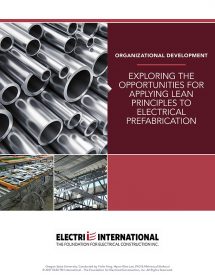Exploring the Opportunities for Applying Lean Principles to Electrical Prefabrication
Electrical prefabrication is the practice of fabricating electrical assemblies in a prefabrication shop, then delivering the complete or semi-complete assemblies to the construction jobsite where they are to be installed. By moving part of the traditional electrical work from a jobsite to a prefabrication shop and fabricating electrical assemblies ahead of time, electrical prefabrication can provide benefits such as increased productivity and safety, decreased jobsite congestion, reduced waste, improved product quality, and cost savings. However, electrical contractors have not fully achieved the potential benefits of prefabrication because of unique barriers that the electrical industry faces when they try to increase the level of their prefabrication.
Previous studies have shown that the application of lean principles to construction is beneficial for prefabrication. However, little to no studies has investigated how the application of lean principles to electrical prefabrication can help overcome the unique barriers. Thus, the goals of this study are to explore the opportunities for applying lean construction principles to electrical prefabrication, and accordingly to facilitate the implementation of prefabrication.
The Oregon State University research team of Yizhe Yang, Hyun Woo Lee, and Mahmoud Shakouri built the study upon two premises. First, electrical construction lags behind mechanical construction in terms of prefabrication. Second, the application of lean construction principles is beneficial for prefabrication.
Using a combination of interviews and case studies, the investigative team worked to determine the unique prefabrication barriers that electrical contractors face, to identify the lean construction principles that would help overcome such barriers, and to demonstrate effective ways to apply lean principles to electrical prefabrication.
The case studies used for this report included four projects of different electrical prefabrication levels: Hanger Cables for Lighting Fixtures; Conduit Bending without BIM; Conduit Bending with BIM; and Electrical Box Assemblies. Photographs and flow charts for each case study amplify the text presented in the report.
In their conclusion, researchers reconfirm the original hypothesis that projects with more lean principles in place provide more opportunities for electrical prefabrication. However, they also note that the full benefits of prefabrication for electrical construction will only be reaped when the culture of continuous improvement within each company is created and the prefabrication process is streamlined.


